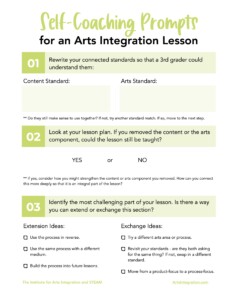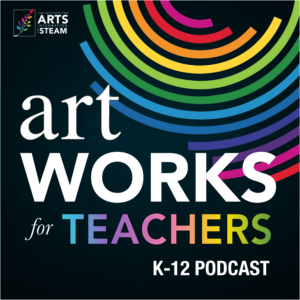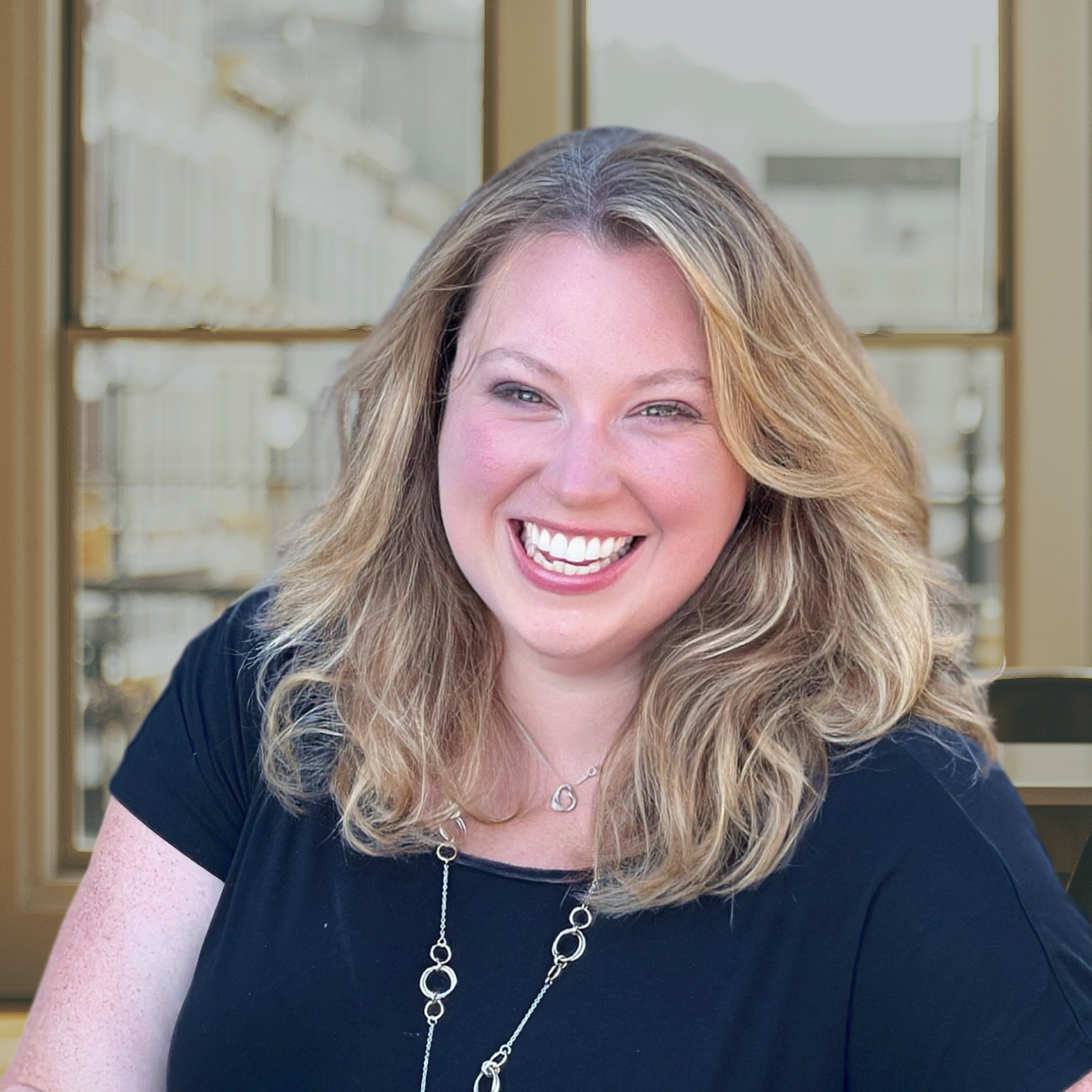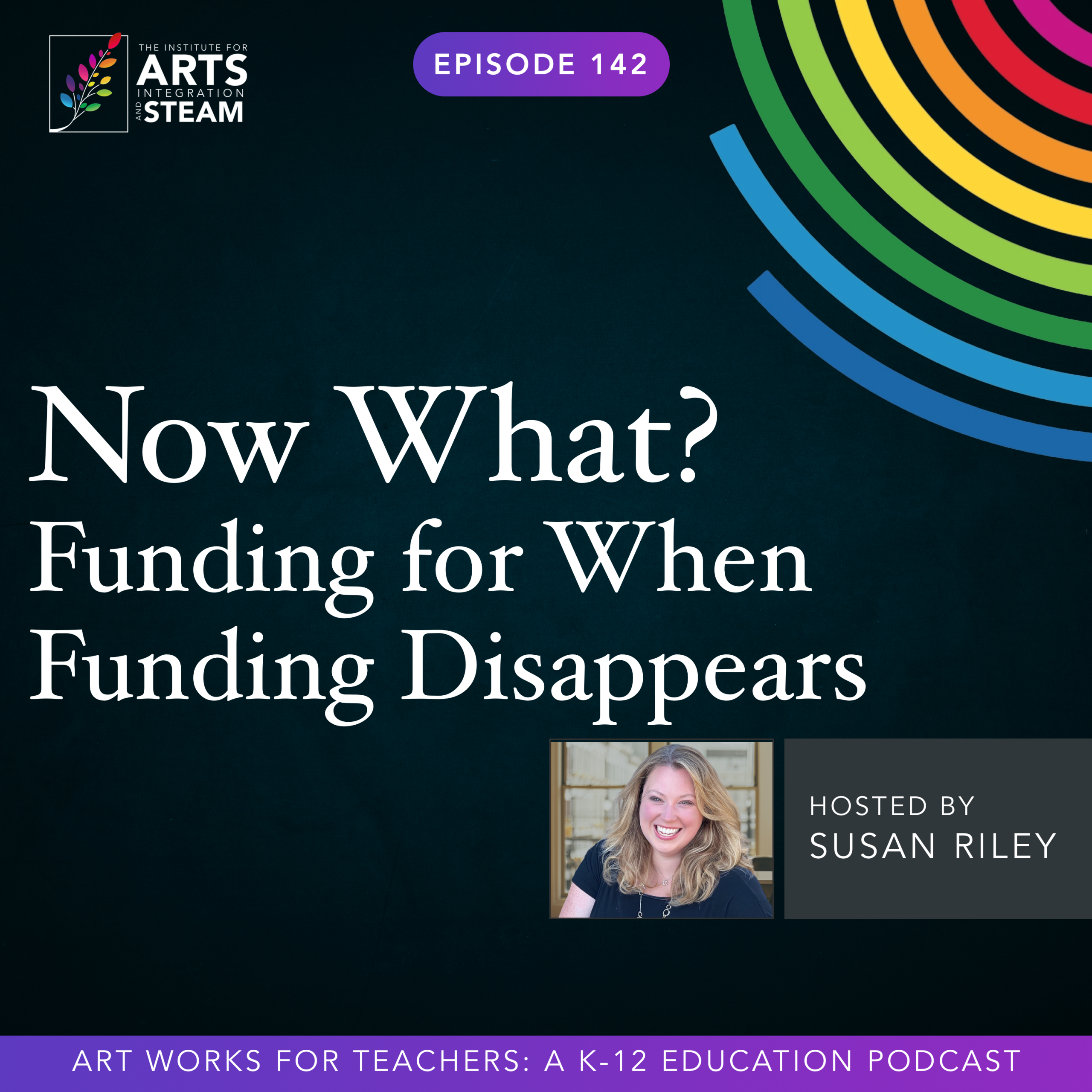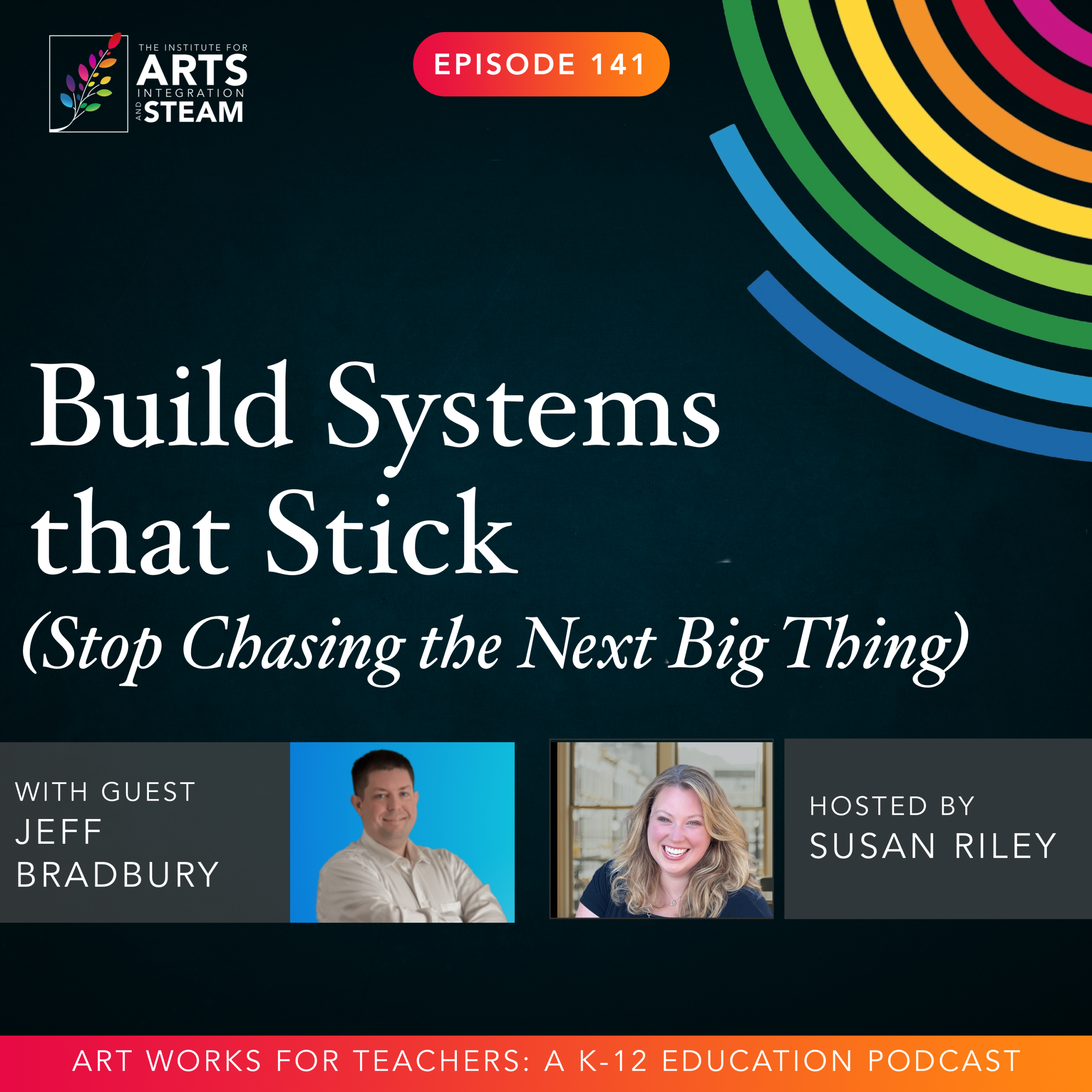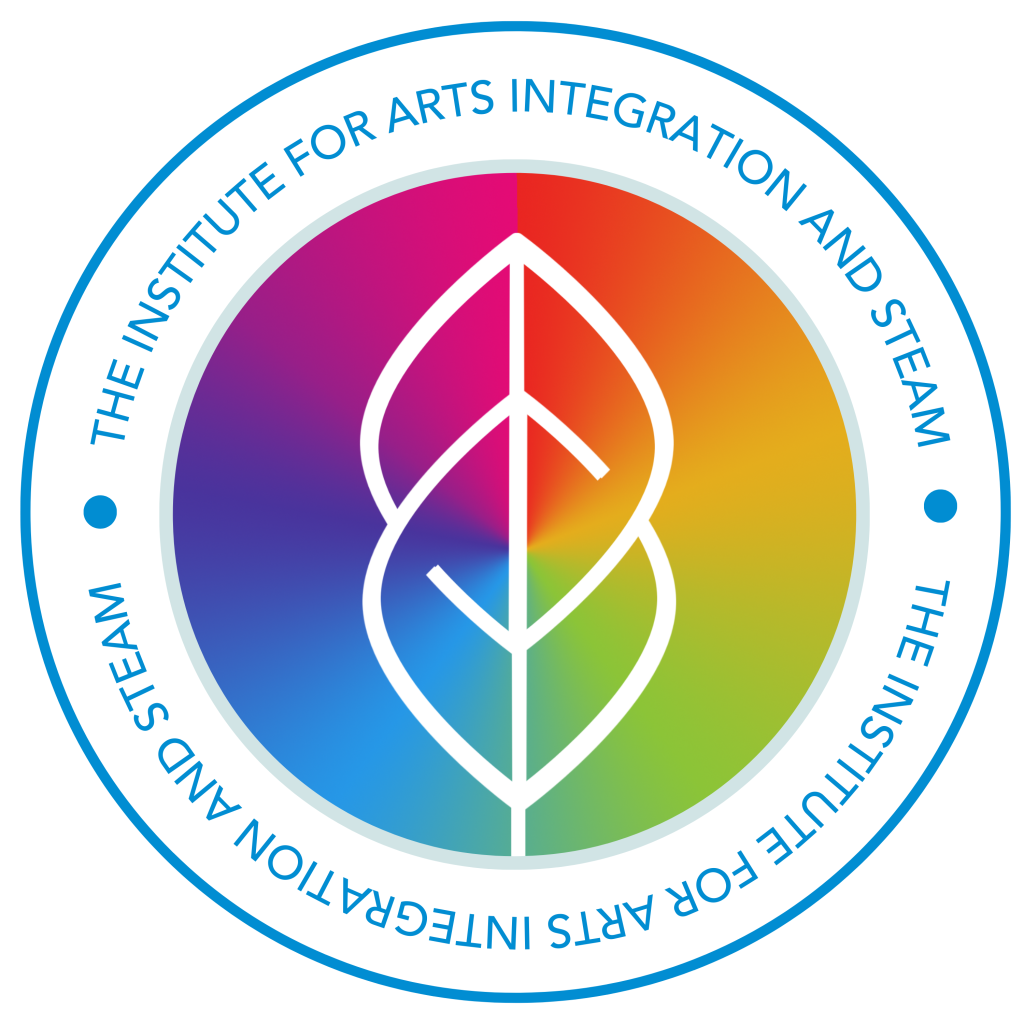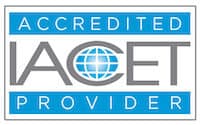ART WORKS FOR TEACHERS PODCAST | EPISODE 018 | 28:36 MIN
How COVID (and Certification) Improved My Teaching
Enjoy this free download of Self-Coaching Prompts for an Arts Integration Lesson.
Susan
Hello, Heather. I’m so glad you’re joining us today. Hi.
Heather
Thank you for having me.
Susan
Of course, of course. So would you take a minute and just introduce yourself to the audience, let us know about you, what you do, and who you are.
Heather
Yeah. So my name is Heather Kasden. I live in Carey, North Carolina, but work in Durham, North Carolina.
This is my eighth school year teaching. I’ve taught students in kindergarten through eighth grade visual art. But this year I’m focusing on kindergarten through fourth grade. I have three young girls, three daughters, which is really makes life really fun and crazy. So I’m trying to teach and be a mom.
Yeah. But yeah, and I also received my arts integration certification from the Institute last. Yeah.
Susan
Which, and you are one of the star pupils. I gotta tell you. I get to listen to all the coaches. That’s my like, behind the scenes thing. And everybody all the time was like, oh my gosh, Heather is so amazing.
You have to meet Heather. So now I’m excited cause I didn’t meet you. And it’s not like anybody gets a bad report, by the way. You know what I mean? But like the people who just stand out to us who like, get it. It just comes a little bit naturally or it, they may struggle, but at the same time they’re, they persevere and they really work hard towards it.
Those are the people who really stand out. So you definitely stood out to our coaches. So I’m excited.
Heather
I did the certification during the remote learning year and so there was a lot of like, or no, that was actually last year, so nevermind that. See, clearly I’ve lost time, but going back to school, it was like a really big transition.
So yeah, I really appreciate that.
Susan
That kinda, oh, yeah. So, so let me ask you about, I wanna talk about remote learning in general for you first before we even talk about adding certification into the mix to that. So when it came to remote learning, of course, I think this year is…I’m not gonna call it normal cuz nothing is normal anymore.
Right. This is maybe our new normal, right? Yes. So this year is better than maybe the last two years. How did remote learning maybe change how you teach now?
Heather
Yeah, so when we shut down in March, there was a, I mean, we were all under that impression that we were coming back in two weeks. And then it kept getting pushed back.
And so to close out that school year, our remote learning was just asynchronous work on Google Classroom and having some live office hours. And that was really nice. I think it was a smart way to end out at least in our art and enrichment classes. Especially cuz I had my, I have a, my five year old was then two, or just had turned three and my twins were seven months old.
And so it was a, there was a lot of diaper changes on Zoom, like with the camera outta focus with me talking to my students. And so, whew, that was a lot. But the the 2020-21 year where we were, we were fully remote that year and I think that, you know, I approached it as art is just gonna look very different and that’s okay.
We did a lot more, you know, we passed out a lot of materials, but we, I work at a Title I school. We and also Covid all had a lot of challenges to families and so we couldn’t expect students to have paint or even crayons. And so I, we would send things home quarterly, but a lot of things had to be done digitally.
And I think what helped me, or it changed me is I integrated a lot more writing, especially because that was a really big focus for our school during Covid. And then also just looking at the gap and like thinking about like literacy. As we returned into in-person. I focused more on writing and still continue to do so.
And I think it also helped me look at art history, but not only in the historical form, but also like what’s happening right now and what’s really interest, what’s, what are students interested in? And I think also because. I was go, we were going through this remote learning together for the first time.
The students that were my students during that year, we are very close. And I think it’s just, there’s a, there’s a bond between us because we were, we were together in this weird, weird way, I was in their home and like they were in my home and you know, I got to meet their cats. And so I think like we just, it was just a very, an interesting time that that bond I don’t think would come back.
Well, it would, wouldn’t, it won’t be the same with my students moving forward, because I think we just were very vulnerable all together.
Susan
Yeah. And as Brene Brown says, you know, vulnerability can really tie people together in a unique way that’s, that’s different than anything else. So, yeah. So in terms of this year, so you’ve had this, and I feel like this year is, is better, but it’s so different because particularly I think fifth graders, eighth graders and second graders, those particular grades for various reasons but because like second graders have never had a full in-person experience until this year. Right. And fifth graders when they left were babies. They were, they were that transition year of third grade, which is so important. They didn’t get, and so they’re having it now, which is interesting for fifth graders having that transition now.
And the same for eighth graders, you know, when they’re, they’re coming into a, a school environment. So having that plus having students who you’ve had this bond with now and having new ones. I mean, cuz you are working with kindergarten through fourth grade, right? Yeah. So having brand new babies who have no experience with this whatsoever, how do you feel like this year is playing out for you?
Heather
Well, I will say that this year is so much better. Last year was I think my hardest year in education even harder than remote learning. And I think a lot of that has to do with, there was a high expectation of like, okay, we’re going back and it’s gonna be beautiful. I remember driving to, on the first day of school, really emotional and being like, we haven’t been in this building and it’s really special.
And then it kinda just went downhill a little bit. Only cause, you know, we went back to like what we were before. And I think in education, I mean, we’re all like, personally we’re all different now, like in some sort or fashion, but I think education is changing. And to go back without any, hange is really challenging.
And so, you know, our students were, and staff were not ready for a full day of school or so then again, and we also wore masks. And so and that was like brought, just brought different behavior challenges than we anticipated, like students just being like, I’m not pulling it up. And then it’s just like, what, this is not what we imagined at the beginning of the year.
And so I think this year I think it’s just, okay, now everybody is back to kind of just being used to being back in person and what that means. And but, so yeah, this year I would say that my third and fourth grade, or my second, third and fourth graders, I all taught during the remote learning year.
And I think even for second graders who were in kindergarten, they’re still catching up. I mean, like there’s projects that we didn’t get to do. I’m still me and creating my curriculum. I am like piecing everything together because I was like, oh, you haven’t ever done that before. You weren’t in the art room in kindergarten.
We actually need to change a project. So you learn these skills in order to get move forward. And so that’s been challenging. Also, our current second graders and fourth graders didn’t have art last year at the return. They had technology instead. And so that is also like another thing.
So I’m still, I think for the next few years, piecing together my curriculum and kind of, which is really good though. I think it needs we need to always reevaluate and reflect each year, but then also just knowing, okay, that’s not gonna work now that we are in this like post. Post covid like in a more tech integrated world, so I’m still navigating.
Susan
As we all are. Right? Yeah. So so other than writing now you said that write, well first let me back up. Yeah. You said that writing is something that when you leverage that during remote learning, that’s something that has stuck and is something that you’re continuing to use now.
Yeah. So talk to me a little bit about how you’re using writing now and then. What other components may have stuck from, from remote learning that you’re using now?
Heather
Yeah, so for literacy, I think, so a big push on our specials team last year was vocabulary. And so really thinking about, I mean, actually my school does a really good job at saying like, writing and literacy is not just for ELA teachers, it’s for everybody.
It’s an infused and integrated everywhere. And students do groan a little bit when you’re like, okay, we’re writing something. And they’re like, no, this is art, this is PE. What are you doing? But so I think essentially it begins with vocabulary and explicitly teaching vocabulary. I think that was a really big push.
I did a lot of professional development with my team last year on, on that. And as well as our literacy coaches for the whole school. So thinking about like how we’re giving contextual and background knowledge. And then the other thing is, is I’m actually implementing, so writing in terms of like, thinking about artist statements or writing about their process and sequential order.
And so a lot of that is collaboration with our literacy coach and as well as the classroom teachers to really think about, okay, like what kind of accommodations should I be giving for, for students or you know, our third graders. I just did a writing prompt where you know, they planned out, we made an art, we made a color field artwork based on a memory of our emotions, and we looked at Mark Rothko and Annie Alberts, which like, I’m just, I love color and so this is just me making art with them.
But we so we planned out, we did like a worksheet that actually, like who are the characters? Who are, who is, what is the plot? What is the problem solution, what’s the setting? And then, you know, picking colors from that. And then they painted their artwork and then now they’re telling me the story which they’ve all done orally, but writing it is such a different beast.
It is. And even basic sentence structure orally is really challenging. And so it becomes like more of like a one-on-one or small group at tables. And so then, but it was, I did, I did kind of just leave it open-ended and I saw, you know, there’s, you know, not only just like spelling or like lack of periods, right? You’re right, grammar! But it’s kind of just like, how do I, I can tell you my, I can tell you the story in order, but writing it, it’s like you forget. And actually it was really special. A student did this on his work and now it’s helping me form, like my next third grade group.
But he just did like the. Then next to last. And so having those basic sentence structures. And so, and then when I did that, it actually like clicked for some students. And so I think, I mean, I’m clearly always learning from our students. But it is something that students and teachers appreciated us, like really implementing that. And so then I would send the the writing prompts to the teachers so that they could look at it and see like, oh, like I’ve seen some improvement, or like, next time this might be helpful. And so we’re doing a lot more writing as like right before break and now when we return.
And so, and really focusing on that with third and fourth grade and then really focusing on vocabulary with K, 1 and 2.
Susan
So now this is interesting. So then my, my arts integration brain starts to click when you start, when we start to fire, like these ideas. So I’m curious, have you, have you done that project backwards where you look the art in terms of creating the composition? Yeah. Because I mean, and we often do this with a, with an artist statement, right? But the idea and explicit in instruction of, oftentimes artists don’t just put paint on a canvas. There’s a, there’s a rhyme and a reason to the process that they are composing, right.
The, the art piece that they’re working. And so I’m curious if you’ve, if maybe this is an extension or if it’s something that you’ve thought about if once you do it the first way that we then flip it and then use that same composition of first, then this. Yes, and then the end, right? We use that same process to layer the paint or to lay down a different process of maybe if you’re working with clay next.
Heather
Yes. Those people. I like that idea. Yeah. Of the, and I think like something that I am thinking about is like writings and like process and how do we get there? And we are working with Clay when we get back, so I, yeah. Now there’s ideas. Yeah, and I think I’ve noticed that in first grade I actually just like, because it’s on my brain.
I saw another teacher, like, and students writing something about winter, but it was just like the first, then next class. And so I, yeah, I think I’m just gonna be utilizing that. Yeah. Only in like, Instruction, but like, but also it’s like, yeah, so first we do this, then okay, now tell me about it. And so yeah, I think that it has a lot of, and then it then it’s not so foreign when you are getting into writing.
It’s almost expected. Yeah. If you’re able to, until students are able to be a little bit more critically thinking and able to be creative in their writing
Susan
Yep. And I also think there’s, there’s value in being almost overly explicit in the process. So like saying this was the writing process, it’s the very same thing in the composition process because they’re the same, we’re just using a different tool.
Yes. This time around. And I think sometimes we miss that. Like we, we assume that they make that connect. Yeah. That students make that connection, but sometimes they don’t. And, and I say that not just for students in school, but like, you know, with adults too, Right. Adults too. It’s just, it’s human nature.
Yeah.
Heather
And actually this conversation is making me think, so where I’m doing a similar project with fourth grade after our clay work. And and so I always tell a story. I tell my story of when I was six years old and fell asleep on the school bus, and I am like overly detailed in like how I was feeling and like the, the colors of where I was and just so that they can see like how I’m getting there.
Yep. But yeah, using that language, like just having that language all the way throughout the process. That’s really good. I, I’m gonna go to my lesson plans and script it a little bit.
Susan
I like that. Yeah, I like that. I like being able to collaborate and kinda connect on, on just, and it’s, it’s just something that naturally happens, of course, I think with teachers.
Yeah. So that springboards me to a little bit about how now, first of all, why did you make a decision to go through certification during remote learning? Because, that, that’s a lot.
Heather
A lot. Well, originally I was actually going to sign up in 2019, but I found out I was pregnant with twins. And so I was like, that is not the time, not the time to do it,
And so then, you know, the following year I was like, okay, my kids are still too small. Like and at that time, I can’t remember if the application page might, or process was before the shutdown or like during,
Susan
it was like right before and then crossed over like I think it ended March 15th and then,
Heather
you know, I was like, my twins are still really small.
I have, I have three small kids. There’s something weird happening in the world and I dunno what it is. And so I waited and I signed up. Yeah, I signed up the following year. So it was, yeah, I did it for the 2020-21 school year. Yeah. And so I really felt, well, like during remote learning, I was like, okay, I really feel like I want, I feel a need like in my process and for my students, but in a need in my journey too to really explore arts integration.
And for me, I think. Arts and social justice, justice and arts and arts integration is really important to my own practice. And so I, I’ve, I’ve used I’ve taken some, I took some courses with the institute before and so I kind of knew a little bit about arts integration. And so I was doing it to what I thought it was and it was not so, it was very much like using strategies but not yet fully arts integration.
And so I really was just, I think I was ready and I think, like I, you know, I didn’t know what the school year was going to bring either. But it really felt, and my school was really supportive of it and wanted to support in that journey. And yeah, I just really felt like it was the right time and it, it’s been something that I was looking at for a while.
Susan
Yeah. And I, I find that with a lot of people that it’s, I mean, cuz it’s a big investment, but also not just money-wise, but also time-wise. I mean, it’s a full year and this year we’re changing it up a bit in that people can go through independently if they want and then if there’s a sprint where they feel like, I really want a mentor here and I would highly recommend that for sprints one and two.
I don’t know about you, but I would totally do that. And that way they can, they can add those on if they want or they can add a coach for the entire process that they want. Yeah. But that I think gives people a little bit of flexibility with time and, and also with their budgets. But I think even that, with all of that aside, it’s an intensive program, right?
There’s there’s so much information in it that we kind of pack in these robust video lessons that you get and then to try to apply all of. It’s a lot so that the, your group, when y’all graduated, I was so proud because not be, not just because of the quality of work, which was super high, but also because you were doing that in the midst of everything.
Yeah. With remote learning. So so like I said, I’m like a proud mama on, on all of you for that year. So I’m curious though, about how when you went through the program, how did that then manifest itself in your teaching? Have you seen some sort of shift in that?
Heather
Well, I first wanna say, I think it’s really important if you’re going through this certification process to have a mentor.
I, I emailed Evelyn so many random questions, and ideas, and so, and she told me by the end, she’s like, she said that she would love being talking to me on Zoom because I would just talk and then I’d be like, oh yeah, that’s what it is. I’m just figuring it out through my questions. Yeah. And I was like, I just need someone to process with.
I need someone to be like, yeah, that’s the right direction. Yeah. And Typhani is also like her Her mini courses or her mini, I think they were called mini courses. Mini lessons. Yeah, mini lessons. That was really helpful too. And so, yeah, I can’t imagine going through it without some kind of mentor even org community to just be like, yeah, that’s normal.
You’re feeling, yeah, you’re going the right way. Yes. But yeah, so how it’s, I can see it coming into my, now that I’ve done the program and I’m, and now I’m teaching, I think I am approaching my curriculum in a very different way. And again, like not every lesson fits into an arts integration model.
And so really also being intentional about where, how. When it’s going in and like at my school I think it’s changing next year, but our elementary students still don’t have social studies and science and that was a direct impact from Covid where last year when we returned in person it was we just need to focus on ELA and math.
And, you know, a lot of teachers tried to integrate social studies and science into their ELA lessons, which I think works a little bit, but it’s not the same. And so I really think about, I think about those social studies, like how to integrate social studies and science. It’s not perfect. Mainly because I’m also, you know, none of our elementary teachers teach it.
And so great. Great. I think that’s really that’s challenging. I can work backwards with our middle school science coach or like middle school science teachers, but it is challenging, mm-hmm. when nobody’s teaching it. And so that’s, so then it’s, you’re, you are also introducing the content and Yeah.
It becomes a little bit hard. But I can see that I’m much more intentional at what I’m, what I’m teaching. and just like now, like with the painting lesson and writing, I really am collaborating more with teachers. Mm-hmm. and teachers, classroom teachers are also wanting to collaborate and so I think it’s opening a door and opening a process and curiosity of how to best reach and serve our students.
Susan
Yeah, I, and you just said the magic word. I think that, you know as we’re starting off a new year, we sometimes pick a word, and I think my word for this year is gonna be curiosity. I think the more I study creativity, the creative process, the more I talk with other people the more clear it’s becoming.
That creativity is really all about curiosity. Yeah. And following that curious thread, wherever it goes. So I’m glad that the, the teachers in your building and that you are both being able to follow that curious thread together. Right. That’s amazing. So before we close out, I always ask the same question and of everybody, if there was one thing that you would like people to know about creativity, what would it be?
Heather
Oh boy, I’m gonna think about that question for a long time. I think. Can you repeat it for me so that I can really fully,…
Susan
Yep. If there’s one thing that you would like people to know about creativity, what would it be?
Heather
That I think that creativity has a lot of branches, like if we think of it as a tree, it has a lot of branches and that sometimes it comes naturally creativity, just like some, for some of us, it comes really instinctually and we’re immediately able to like not only just create, but also to problem solve creatively and really think about the world in a way.
I think also creativity takes a lot of practice. I really think about myself in that. Cuz since having children and teaching full-time, it’s really hard to have a personal art practice. And that’s something that I really want. And so I think it just takes practice and intentional planning sometimes even if it’s just like for an hour.
I’m, I’m committing to being creative. I don’t know what that means, but I’m just gonna be surrounded by something creative. Yeah. And I think too, again, like yeah, I think I’m gonna have the same word as you, like being curious and having that curiosity. Creativity takes a lot of process. It’s not just about an end product, but it’s really.
About the journey with it, so, I think there’s probably more branches, and I’m gonna think about that. I’ll have a better answer for you after we’re done recording, but I, I really appreciate that question. I really liked it.
Susan
Yeah, no, it’s, and I like, love your metaphor and the idea that, you know, some people, some people can climb a tree and it’s no big deal. And other people, you look at the tree for a really long time to figure out where your first step is, right? Yes. Yes. So I love that metaphor of the tree for creativity. So thank you for that. Thank you. And thank you for being a part of our community.
I just, you add such value and joy and positive vibes to everything that you bring, Heather. So thank you so much for joining me today.

